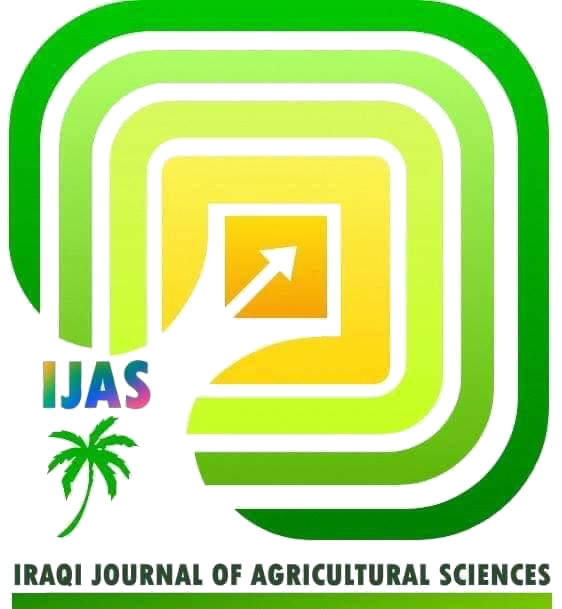MOLECULAR DETECTION AND PHYLOGENETIC ANALYSIS OF FASCIOLA GIGANTICA ISOLATED FROM BUFFALOES AT AL-MUTHANNA PROVINCE, IRAQ
DOI:
https://doi.org/10.36103/1q18gs38Keywords:
liver fluke, pcr, sequencing, mitochondrial DNA, NADH, geneAbstract
The aim of this study was to identify and differentiate between Fasciola gigamtica and Fasciola hepatica infections in buffaloes, through the application of PCR technique. Also, includes investigate the characteristics of phylogenetic analysis for Fasciola gigantica based on partial mitochondrial DNA. The application of polymerase chain reaction technique (PCR) in molecular diagnosis was exhibited high levels of specificity and sensitivity in identifying both species of Fasciola depend on two different genes NADH 6 for F. hepatica and NADH 4 for F. gigantica. Moreover the percentage of infection by F. hepatica and F. gigantica were recorded using specific different primers to be 0% and 100 % respectively. The results of the sequencing and phylogenetic tree showed 99% identification with three China isolate (MH621335.1, GU121036.1, GU121037.1), and 98% identification one China isolate. Furthermore, the results showed 100% identification with two Niger isolate (GU121056.1, GU121048.1), and 99% identification with two Niger isolate (GU121047.1, FJ392263.1) based on sequence analysis of mitochondrial NADH 4 gene (ND4). Thus, the current study concluded that the phylogenetic analysis exhibited a significant genetic resemblance between the strains from Iraq and Niger.
References
1. Ahasan, S. A., M. Adela Valero, E. H. Chowdhury, M. T. Islam, M. R. Islam, M. M. H. Mondal, R.V. Peixoto, L. Berinde, M. Panova and S. Mas-Coma. 2016. CIAS detection of Fasciola hepatica/ F. gigantica intermediate forms in bovines from Bangladesh. Acta Parasitologica. 61(2): 267-77. https://doi.org/10.1515/ap-2016-0037
2. Ai, L., M. X. Chen, S. Alasaad, H. M. Elsheikha, J. Li, H. L. Li, R. Q. Lin, F. Zou, X. Q. Zhu and J. X. Chen. 2011. Genetic characterization, species differentiation and detection of Fasciola spp. by molecular approaches. Parasites and Vectors. 4 (101):1-6.
https://doi.org/10.1186/1756-3305-4-101
3. Ai, L., Y. B. Weng, H. M. Elsheikha, G. H. Zhao, S. Alasaad, J. X. Chen, J. Li, H.L. Li, C. R. Wang, M. X. Chen, R. Q. Lin and X. Q. Zhu. 2011. Genetic diversity and relatedness of Fasciola spp. isolates from different hosts and geographic regions revealed by analysis of mitochondrial DNA sequences. Veterinary Parasitology. 181(2-4): 329-334. https://doi.org/10.1016/j.vetpar.2011.03.057
4. Al-Amery, A. R. and A. M. A. Al-Amery. 2022. Molecular diagnosis of cryptosporidium ssp. in water buffaloes at Babylon province, Iraq. Iraqi Journal of Agricultural Sciences. 53(1): 147-156. https://doi.org/10.36103/ijas.v53i1.1519
5. Al-Saedy, J. K. 2007. Iraqi Buffalo Now. Proceedings 8th World Buffalo Congress. Italian Journal of Animal Science. 6(2):1234-1236.DOI: https://doi.org/10.4081/ijas.2007.s2.1234
6. Alshaibani, H. A. A., A. J. A. K. Alqaraghli and M. A. Y. Alzaidi. 2024. Fasciola gigantica parasitic infection in slaughtered cows and buffaloes. Journal of Animal Health and Production. 12(s1): 133-138. http://dx.doi.org/10.17582/journal.jahp/2024/12.s1.133.138
7. Alsulami, M. N., M. H. Wakid, M. Al-Matary, R. Abdel-Gaber, W. A. I. Al-Megrin, A. O. Bakhraibah, A. D. Alanazi, H. A. Elshabrawy and A. M. El-Kady. 2022. Identification and Genetic Characterization of Fasciola hepatica Isolated from Cattle in Jeddah, Saudi Arabia Based on Sequence Analysis of Mitochondrial (COI) Gene. Infection and Drug Resistance. 15: 4877–86. https://doi.org/10.2147/IDR.S375671
8. Amor, N., A. Halajian, S. Farjallah, P. Merella, K. Said and B. Ben-Slimane. 2011. Molecular characterization of Fasciola spp. from the endemic area of northern Iran based on nuclear ribosomal DNA sequences. Experimental Parasitology. 128 (3): 196-204. https://doi.org/10.1016/j.exppara.2011.03.011
9. Ashrafi, K., M. A. Valero, M. Panova, M. V. Periago, J. Massoud, and S. Mas-Coma. 2006. Phenotypic analysis of adults of Fasciola hepatica, Fasciola gigantica and intermediate forms from the endemic region of Gilan, Iran. Parasitology International. 55(4): 249-260. https://doi.org/10.1016/j.parint.2006.06.003
10. Bargues, M. D., P. Artigas, M. Khoubbane, R. Flores, P. Glöer, R. Rojas-Garcia, K. Ashrafi, G. Falkner and S. Mas-Coma. 2011. Lymnaea schirazensis, an overlooked snail distorting fascioliasis data: genotype, phenotype, ecology, worldwide spread, susceptibility, applicability. PLoS One. 6(9):1-33. https://doi.org/10.1371/journal.pone.0024567
11. Bargues, M. D., V. Gayo, J. Sanchis, P. Artigas, M. Khoubbane, S. Birriel and S. Mas-Coma. 2017. DNA multigene characterization of Fasciola hepatica and Lymnaea neotropica and its fascioliasis transmission capacity in Uruguay, with historical correlation, human reportc review and infection risk analysis. PLOS Neglected Tropical Diseases. 11(2):1-33. https://doi.org/10.1371/journal.pntd.0005352
12. Beesley, N.J., C. Caminade, J. Charlier, R. J. Flynn, J. E. Hodgkinson, A. Martinez‐Moreno, M. Martinez‐Valladares, J. Perez, L. Rinaldi and D. J. L. Williams. 2018. Fasciola and fasciolosis in ruminants in Europe: Identifying research needs. Transboundary and Emerging Diseases. 65(1): 199–216. https://doi.org/10.1111/tbed.12682
13. Chamuah, J. K., O. K. Raina, H. , S. S. Jacob, M. Sankar, A. Sakhrie, S. Lama and P. S. Banerjee. 2016. Molecular characterization of veterinary important trematode and cestode species in the mithun Bos frontalis from northeast India. Journal of Helminthology. 90(5): 577-82. https://doi.org/10.1017/S0022149X15000772
14. De Agüero, V. C. G., J. Luka, J. Gandasegui, E. Valderas-García, O. J. Ajanusi, N. P. Chiezey and M. Martínez-Valladares. 2020. Fasciola hepatica and Fasciola gigantica coexistence in domestic ruminants in Nigeria: application of a PCR-based tool. Tropical Animal Health and Production. 52(6): 3893-3897.
https://doi.org/10.1007/s11250-020-02333-3
15. El-Tahawy, A. S., E. K. Bazh and R. E. Khalafalla. 2017. Epidemiology of bovine fascioliasis in the Nile Delta region of Egypt: Its prevalence, evaluation risk factors, and its economic significance. Veterinary World. 10(10):1241. https://doi.org/10.14202/vetworld.2017.1241-1249
16. Fadhil, A. I., H. H. Abed, S. R. Fadel and M. Th. S. Al-Zubaidi. 2022. Molecular diagnosis of nematode worms Parabronema skrjabini in camels (Camelus dromedaries) in Iraq. Iraqi Journal of Agricultural Sciences. 53(3):584-588. https://doi.org/10.36103/ijas.v53i3.1567
17. Galtier, N., B. Nabholz, S. Glémin and G. D. D. Hurst. 2009. Mitochondrial DNA as a marker of molecular diversity: A reappraisal. Molecular Ecology. 18(22):4541-50. https://doi.org/10.1111/j.1365-294X.2009.04380.x
18. Halakou, A., H. Khazan, M. Bendehpour and B. Kazemi. 2017. Morphological Study of Fasciola Parasites Isolated from Cattle and Sheep in Golestan Province (Iran). Novelty Biomedicine. 5(4):166–71. https://doi.org/10.22037/nbm.v5i4.15589
19. Heydarian, P., A. J. Mamaghani, E. Hajialilo, A. Bozorgomid, M. A. Mohaghegh, M. Aryaeipour, M. J. A. Afshar and V. Jajarmi. 2023. Identification and differentiation of Fasciola hepatica and F. gigantica using multiplex PCR technique. Annals of Parasitology. 69(2): 67–74. https://doi.org/10.17420/ap6902.511
20. Hodzic, A., A. Zuko, R. Avdic, A. Alic, J. Omeragic and A. Jazic. 2013. Influence of Fasciola hepatica on serum biochemical parameters and vascular and biliary system of sheep liver. Iranian Journal of Parasitology. 8(1): 92-98.
21. Itagaki, T., M. Kikawa, K. Sakaguchi, J. shimo, K. Terasaki, T. Shibahara and K. Fukuda. 2005. Genetic characterization of parthenogenic Fasciola spp. in Japan on the basis of the sequences of ribosomal and mitochondrial DNA. Parasitology. 131(5):679-85. https://doi.org/10.1017/S0031182005008292
22. Itagaki, T., M. Kikawa, K. Terasaki, T. Shibahara and K. Fukuda. 2005b. Molecular characterization of parthenogenic Fasciola sp. in Korea on the basis of DNA sequences of ribosomal ITS1 and mitochondrial NDI gene. Journal of Veterinary Medical Science. 67:1115-18. https://doi.org/10.1292/jvms.67.1115
23. Jasim, H. J. and A. M. Al-Amery. 2023. Biochemical and histopathological changes associated with Fasciola spp in slaughtered buffaloes at Al-Muthanna Province, Iraq. Advances in Animal and Veterinary Sciences. 11(3): 446-52. https://dx.doi.org/10.17582/journal.aavs/2023/11.3.446.452
24. Kock, K. N., C.T. Wolmarans and M. Bornman. 2003. Distribution and habitats of the snail Lymnaea truncatula, intermediate host of the liver fluke Fasciola hepatica, in South Africa. Journal of the South African Veterinary Association. 74 (4):117-22. https://doi.org/10.4102/jsava.v74i4.523
25. Kordshooli, M. S., K. Solhjoo, B. Armand, H. Dowlatkhah and M. E. Jahromi. 2017. A reducing trend of fasciolosis in slaughtered animals based on abattoir data in South of Iran. Veterinary World. 10(4): 418–423. https://doi.org/10.14202/vetworld.2017.418-423
26. Kumar, S., G. Stecher, M. Li, C. Knyaz and K. Tamura. 2018. MEGA X: Molecular Evolutionary Genetics Analysis across computing platforms. Molecular Biology and Evolution. 35:1547-1549. https://doi.org/10.1093/molbev/msy096
27. Lalor, R., K. Cwiklinski, N. E. D. Calvani, A. Dorey, S. Hamon, J. L. Corrales, J. P. Dalton, C. De Marco-Verissimo. 2021. Pathogenicity and virulence of the liver flukes Fasciola hepatica and Fasciola gigantica that cause the zoonosis Fasciolosis. Virulence. 12(1): 2839-67. https://doi.org/10.1080/21505594.2021.1996520
28. Le, T. H., D. Blair and D. P. McManus. 2002. Mitochondrial genomes of parasitic flatworms. Trends in Parasitology. 18(5): 206-213.
https://doi.org/10.1016/s1471-4922(02)02252-3
29. Mas-Coma, S., M. D. Bargues and M. A. Valero. 2005. Fascioliasis and other plantborne trematode zoonoses. International Journal for Parasitology. 35(11-12): 1255–78. https://doi.org/10.1016/j.ijpara.2005.07.010
30. Matanović, K., K. Severin, F. Martinković, M. Šimpraga, Z. Janicki and J. Barišić. 2007. Hematological and biochemical changes in organically farmed sheep naturally infected with Fasciola hepatica. Parasitology Research. 101: 1657-61.
https://doi.org/10.1007/s00436-007-0709-2
31. Mehmood, K., H. Zhang, A. J. Sabir, R. Z. Abbas, M. Ijaz, A. Z. Durrani, M. H. Saleem, M. U. Rehman, M. K. Iqbal, Y. Wang, H. I. Ahmad, T. Abbas, R. Hussain, M. T. Ghori, S. Ali, A. U. Khan and J. Li. 2017. A review on epidemiology, global prevalence and economical losses of fasciolosis in ruminants. Microbial Pathogenesis. 109: 253–262. https://doi.org/10.1016/j.micpath.2017.06.006
32- Minervino, A. H. H., M. Zava, D. Vecchio and A. Borghese. 2020. Bubalus bubalis: A Short Story. Frontiers in Veterinary Sciences. 7:1-15. https://doi.org/10.3389/fvets.2020.570413
33- Mucheka, V. T., J. M. Lamb, D. M. Pfukenyi and S. Mukaratirwa. 2015. DNA sequence analyses reveal co-occurrence of novel haplotypes of Fasciola gigantica with F. hepatica in South Africa and Zimbabwe. Veterinary Parasitology. 214(1-2): 144-151. https://doi.org/10.1016/j.vetpar.2015.09.024
34. Oyesola, O. O., C. O. S. Souza and P. Loke. 2022. The Influence of Genetic and Environmental Factorsand Their Interactions on Immune Response to Helminth Infections. Frontiers in Immunology. 13:1-13 https://doi.org/10.3389/fimmu.2022.869163
35. Raina, O. K., S. S. Jacob, M. Sankar, D. Bhattacharya, S. Bandyopadyay, A. Varghese, J. K. Chamuah and H. Lalrinkima. 2015. Genetic characterization of Fasciola gigantica from different geographical regions of India by ribosomal DNA markers. Journal of Parasitic Diseases. 39(1):27-32. https://doi.org/10.1007/s12639-013-0276-7
36. Rokni, M. B. 2008. The present status of human helminthic diseases in Iran. Annals of Tropical Medicine and Parasitology. 102(4): 283-295. https://doi.org/10.1179/136485908X300805
37. Sharbatkhori, M., S. Nasibi, M. A. Mohammadi, M. Aryaeipour, S. Raeghi and M. F. Harandi. 2023. Morphological and molecular characterization of Fasciola isolates from livestock in Golestan province, northern Iran. Veterinary Medicine and Science. 9(4): 1824–32.
https://doi.org/10.1002/vms3.1189
38. Shrimali, R. G., M. D. Patel and R. M. Patel. 2016. Comparative efficacy of anthelmintics n and their effects on hemato-biochemical changes in Fasciolosis of goats of South Gujarat. Veterinary World. 9(5): 524-529. https://doi.org/10.14202/vetworld.2016.524-529
39. Walker, S. M., P. A. Prodöhl, H. L. Fletcher, R. E. B. Hanna, V. Kantzoura, E. M. Hoey and A. Trudgett. 2007. Evidence for multiple mitochondrial lineages of Fasciola hepatica (liver fluke) within infrapopulations from cattle and sheep. Parasitology Research. 101: 117-125.https://doi.org/10.1007/s00436-006-0440-4
40. Youssef, A. I. and S. Uga. 2014. Review of parasitic Zoonoses in Egypt. Tropical medicine and health. 42(1): 3–14. DOI: 10.2149/tmh.2013-23
41. Yuan, W., J. M. Liu, K. Lu, H. Li, M. M. Duan, J. T. Feng, Y. Hong, Y. P. Liu, Y. Zhou, L. B. Tong, J. Lu, C. G. Zhu, Y. M. Jin, G. F. Cheng and J. J. Lin. 2016. Molecular identification and seasonal infections of species of Fasciola in ruminants from two provinces in China. Journal of Helminthology. 90(3): 359-363.
https://doi.org/10.1017/S0022149X15000383
42. Zhang, W. Y., E. Moreau, J. C. Hope, C. J. Howard, W. Y. Huang and A. Chauvin. 2005. Fasciolahepatica and Fasciola gigantica: comparison of cellular response to experimental infection in sheep. Experimental Parasitology. 111(3): 154-159. https://doi.org10.1016/j.exppara.2005.06.005
Downloads
Published
Issue
Section
License
Copyright (c) 2025 IRAQI JOURNAL OF AGRICULTURAL SCIENCES

This work is licensed under a Creative Commons Attribution-NonCommercial 4.0 International License.

2.jpg)


